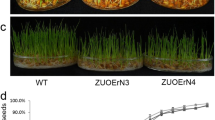Abstract
MOCA1 encodes the last key glucuronosyltransferase for ionic stress sensor glycosyl inositol phosphoryl-ceramide (GIPCs) biosynthesis in Arabidopsis, which indicates that the MOCA gene family play important role in plant tolerance to salt stress. However, the isolation and function of MOCAs in staple crops have not been reported and the downstream targets of MOCAs in salt stress tolerance signalling pathway are not clear. In this study, we identified 110 MOCA genes in wheat which were classified into five clades and they differed in gene structure, protein length, conserved motifs and expression profiles in different tissues and under salt stress. TaMOCA1 was selected for further functional study in response to salt stress. TaMOCA1 was rapidly induced by NaCl treatment. The 35S::TaMOCA1-GFP construction showed the cell nucleus and cytoplasm location in wheat protoplast. TaMOCA1 over-expressing Arabidopsis seedlings formed longer primary roots and more lateral roots than the wild type ones under 50 mM NaCl treatment. The over-expressing Arabidopsis had higher expression levels of HKT1, but lower expression levels of NHX1 and SOS genes than the wild type. Also, the transgenic plants had higher SOD activity and lower MDA content than the wild Arabidopsis seedling under salt stress. These results may indicate that TaMOCA1 increases salt stress tolerance through decreasing Na+ loading from the xylem parenchyma cells to the xylem via SOS1 and HKT1, hence lowering root-to-shoot delivery of Na+ and superior antioxidant ability. All these results lay a foundation for further functional study of MOCAs in wheat.







Similar content being viewed by others
References
Bailey T. L., Williams N., Misleh C. and Li W. W. 2006 MEME: discovering and analyzing DNA and protein sequence motifs. Nucleic Acid Res. 34, 369–373.
Baryla A., Laborde C., Montillet J. L., Triantaphylidès C. and Chagvardieff P. 2000 Evaluation of lipid peroxidation as a toxicity bioassay for plants exposed to copper. Environ. Pollut. 109, 131–135.
Chen Q., Zhang M. and Shen S. 2011 Effect of salt on malondialdehyde and antioxidant enzymes in seedling roots of Jerusalem artichoke (Helianthus tuberosus L.). Acta Physiol. Plant. 33, 273–278.
Ellouzi H., Hamed K. B., Cela J., Munné-Bosch S. and Abdelly C. 2011 Early effects of salt stress on the physiological and oxidative status of Cakile maritima (halophyte) and Arabidopsis thaliana (glycophyte). Physiol. Plant. 142, 128–143.
Gupta P. K., Balyan H. S., Sharma S. and Kumar R. 2020 Genetics of yield, abiotic stress tolerance and biofortification in wheat (Triticum aestivum L.). Theor. Appl. Genet. 133, 1569–1602.
Jia Q., Zheng C., Sun S., Amjad H., Liang K. and Lin W. 2018 The role of plant cation/proton antiporter gene family in salt tolerance. Biol. Plantarum. 62, 617–629.
Jiang Z., Zhou X., Tao M., Yuan F., Liu L., Wu F. et al. 2019 Plant cell-surface GIPC sphingolipids sense salt to trigger Ca2+ influx. Nature 572, 341–346.
Jithesh M. N., Prashanth S. R., Sivaprakash K. R. and Parida A. K. 2006 Antioxidative response mechanisms in halophytes: their role in stress defence. J. Genet. 85, 237–254.
Liang W., Ma X., Wan P. and Liu L. 2018 Plant salt-tolerance mechanism: A review. Biochem. Biophys. Res. Commun. 495, 286–291.
Maathuis F. J. M., Ahmad I. and Patishtan J. 2014 Regulation of Na+ fluxes in plants. Front. Plant Sci. 5, 467.
Rennie E. A., Hansen S. F., Baidoo E. E. K., Hadi M. Z., Keasling J. D. and Scheller H. V. 2012 Three members of the Arabidopsis glycosyltransferase family 8 are xylan glucuronosyltransferases. Plant Physiol. 159, 1408–1417.
Sabagh A. E. L., Islam M. S., Skalicky M., Raza M. A., Singh K., Hossain M. A. et al. 2021 Salinity stress in wheat (Triticum aestivum L) in the changing climate: adaptation and management strategies. Front. Agron. 3, 661932.
Seifikalhor M., Aliniaeifard S., Shomali A., Azad N., Hassani B., Lastochkina O. et al. 2019 Calcium signaling and salt tolerance are diversely entwined in plants. Plant Signal. Behav. 14, e1665455.
Szymańska K. P., Polkowska-Kowalczyk L., Lichocka M., Maszkowska J. and Dobrowolska G. 2019 SNF1-Related protein kinases SnRK2.4 and SnRK2.10 modulate ROS homeostasis in plant response to salt stress. Int. J. Mol. Sci. 20, 143.
Yang Y. and Guo Y. 2018 Unraveling salt stress signaling in plants. J. Integr. Plant Boil. 60, 796–804.
Yang J., Yao R., Wang X., Xie W., Zhang X., Zhu W. et al. 2022 Research on salt-affected soils in China: History, status quo and prospect. Acta Pedologica Sinica. 59, 10–27.
Yu S., Wu J., Wang M., Shi W., Xia G., Jia J. et al. 2020 Haplotype variations in QTL for salt tolerance in Chinese wheat accessions identified by markerbased and pedigree-based kinship analyses. Crop J. 8, 1011–1024.
Zhang M., Cao Y., Wang Z., Wang Z., Shi J., Liang X. et al. 2018 A retrotransposon in an HKT1 family sodium transporter causes variation of leaf Na+ exclusion and salt tolerance in maize. New Phytol. 217, 1161–1176.
Zhang H., Zhu J., Gong Z. and Zhu J. 2022 Abiotic stress responses in plants. Nat. Rev. Gent. 23, 104–119.
Zhao C., Zhang H., Song C., Zhu J. and Shabala S. 2020 Mechanisms of plant responses and adaptation to soil salinity. The Innovation. 1, 100017.
Acknowledgements
The research was supported by the National Natural Science Foundation of China (31871622).
Author information
Authors and Affiliations
Corresponding author
Additional information
Corresponding editor: Manoj Prasad
Supplementary Information
Below is the link to the electronic supplementary material.
Rights and permissions
Springer Nature or its licensor (e.g. a society or other partner) holds exclusive rights to this article under a publishing agreement with the author(s) or other rightsholder(s); author self-archiving of the accepted manuscript version of this article is solely governed by the terms of such publishing agreement and applicable law.
About this article
Cite this article
Qin, Y., Cui, P., Zhang, B. et al. Characters of the MOCA family in wheat and TaMOCA1 function in salt stress tolerance. J Genet 103, 10 (2024). https://doi.org/10.1007/s12041-023-01456-4
Received:
Revised:
Accepted:
Published:
DOI: https://doi.org/10.1007/s12041-023-01456-4




